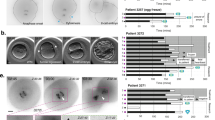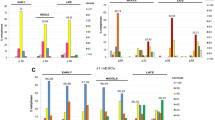Abstract
The frequency and distribution of aphidicolin (APC)-induced common fragile sites (cfs) were analyzed in human embryonic cells of different origins. Embryonic lung fibroblasts (MRC-5), amniocytes (AMNIO) and embryonic retina cells (HERO790) are as sensitive to the APC-induced clastogenic effect as peripheral lymphocytes, whereas embryonic kidney cells (HEK) seem more resistant to the induction of chromosomal gaps and breaks by the drug. Analysis of the distribution of fragile sites confirmed that the expression of specific APC-induced cfs varies in different cells and that the embryonic cell strains show a greater similarity among themselves than to lymphocytes. In addition, HEK, MRC-5, HERO790 and AMNIO cells show specific APC induction of the cfs at the 1p31.2 chromosomal band, which seems to be a distinctive feature of the embryonic stage of cells.
Similar content being viewed by others
References
Baumstark-Khan C (1992) Effect of aphidicolin on DNA synthesis, PLD-recovery and DNA repair of human diploid fibroblasts. Int J Radiat Biol 61:191–197
Berger R, Bloomfield CD, Sutherland GR (1985) Report of the committee on chromosome rearrangements in neoplasia and the fragile sites. Cytogenet Cell Genet 40:490–539
Bouffler S, Silver A, Cox R (1993) The role of DNA repeats and associated secondary structures in genomic instability and neoplasia. BioEssays 15:409–412
Brown T, Dawson AA, McDonald IA, Bullock I, Watt JL (1985) Chromosome damage and sister chromatid exchanges in lymphocytes from patients with two primary cancer. Cancer Genet Cytogenet 17:35–42
Caporossi D, Tedeschi B, Vernole P, Porfirio B, Nicoletti B (1989) Chromosome breakage induced by bleomycin in an ataxia telangiectasia lymphoblastoid line: correlation with fragile sites and Epstein-Barr virus DNA localization. Cytogenet Cell Genet 52:180–185
Caporossi D, Bacchetti S, Nicoletti B (1991) Synergism between aphidicolin and adenoviruses in the induction of breaks at fragile sites on human chromosomes. Cancer Genet Cytogenet 54:39–53
Craig-Holmes AP, Strong LC, Goodacre A, Pathak S (1987) Variation in the expression of aphidicolin-induced fragile sites in human lymphocyte cultures. Hum Genet 76:134–137
Furuya T, Ochi H, Watanabe S (1989) Common fragile sites in chromosomes of bone marrow cells and peripheral blood lymphocytes from healthy persons and leukemia patients. Cancer Genet Cytogenet 43:131–138
Furuya T, Hagiwara J, Ochi H, Tokuhiro H, Kikawada R, Karube T, Watanabe S (1991) Changes of common fragile sites on chromosomes according to the menstrual cycle. Hum Genet 86: 471–474
Kasukawa T, Watanabe T, Endo A (1985) Cytogenetic and cytokinetic analysis of lymphocytes from patients with hereditary adenomatosis of the colon and rectum. Cancer Genet Cytogenet 16:73–79
Koduru P, Chaganti R (1988) Congenital chromosome breakage clusters within Giemsa-light bands and identifies sites of chromatin instability. Cytogenet Cell Genet 49:269–274
Kremer EJ, Pritchard M, Lynch M, Yu S, Holman K, Baker E, Warren St, Schlessinger D, Sutherland GR, Richards RI (1991) Mapping of the DNA instability at the fragile X to a trinucleotide repeat p(CCG)n. Science 252:1711–1714
Li YP, tomanin R, Smiley JR, Bacchetti S (1993) Generation of a new adenovirus type 12-inducible fragile site by insertion of an artificial U2 locus in the human genome. Mol Cell Biol 13:6064–6070
Miguez L, Fuster C, Perez MM, Miro R, Egozcue J (1991) Spontaneous chromosome fragility in chorionic villus cells. Early Hum Dev 26:93–99
Moley JF, Brother MB, Fong CT, White PS, Baylin SB, Nelkin B, Wells SA, Brodeur GM (1992) Consistent association of 1p loss of heterozygosity with pheochromocytomas from patients with Multiple Endocrine Neoplasia Type 2 Syndromes. Cancer Res 52:770–774
Morgan R, Morgan SS, Hecht BK, Hecht F (1988) Fragile sites at 4q23 and 7q11. 23 unique to bone marrow cells. Cancer Genet Cytogenet 31:47–53
Murano I, Kuwano A, Kajii T (1989a) Fibroblast-specific common fragile sites induced by aphidicolin. Hum Genet 83:45–48
Murano I, Kuwano A, Kajii T (1989b) Cell type-dependent difference in the distribution and frequency of aphidicolin-induced fragile sites: T and B lymphocytes and bone marrow cells. Hum Genet 84:71–74
Nordenson I, Beckman L, Liden S, Stjernberg N (1984) Chromosomal aberrations and cancer risk. Hum Hered 34:76–81
Rassool FV, McKeithan TW, Neilly ME, van Melle E, Espinosa III R, Le Beau MM (1991) Preferential integration of marker DNA into chromosomal fragile site at 3pl 4: an approach to cloning fragile sites. Proc Natl Acad Sci USA 88:6657–6661
Romani M, De Ambrosis A, Alhadeff B, Purrello M, Gluzman Y, Siniscalco M (1990) Preferential integration of the Ad5/SV40 hybrid virus at the highly recombinogenic human chromosomal site 1p36. Gene 95:231–241
Sutherland GR, Ledbetter DH (1989) Report of the committee on cytogenetic markers. Cytogenet Cell Genet 51:452–458
Sutherland GR, Mattei JF (1987) Report of the committee on cytogenetic markers. Cytogenet Cell Genet 46:316–324
Tedeschi B, Porfirio B, Vernole P, Caporossi D, Dallapiccola B, Nicoletti B (1987) Common fragile sites: their prevalence in subjects with constitutional and acquired chromosomal instability. Am J Med Genet 27:471–482
Tedeschi B, Vernole P, Sanna ML, Nicoletti B (1992) Population cytogenetics of aphidicolin-induced fragile sites. Hum Genet 89:543–547
Vernole P, Tedeschi B, Caporossi D, Nicoletti B (1988) Common fragile sites and human cancer. A study on lymphocytes from neuroblastoma patients. Cancer Genet Cytogenet 36: 13–23
Warren ST, Zhang F, Licameli GR, Peters JF (1987) The fragile X site in somatic cell hybrids: an approach for molecular cloning of fragile sites. Science 237:420–423
Yunis JJ (1987) Multiple recurrent genomic rearrangements and fragile sites in human cancer. Somatic Cell Mol Genet 13:397–403
Yunis JJ, Soreng AL, Bowe AE (1987) Fragile sites are target of diverse mutagens and carcinogens. Oncogene 1:59–69
Author information
Authors and Affiliations
Rights and permissions
About this article
Cite this article
Caporossi, D., Vernole, P., Nicoletti, B. et al. Characteristic chromosomal fragility of human embryonic cells exposed in vitro to aphidicolin. Hum Genet 96, 269–274 (1995). https://doi.org/10.1007/BF00210405
Received:
Revised:
Issue Date:
DOI: https://doi.org/10.1007/BF00210405




